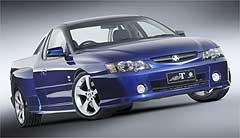Future models - Elfin - MS8 - StreamlinerFirst look: Holden’s retro double1960s look: Holden designed and V8 powered Elfin Clubman MS8 track racer and Elfin Streamliner MS8 roadster. Holden's surprise link with a famed motor racing name produces two new models27 Feb 2004 By BRUCE NEWTON HOLDEN revealed not just one, but two retro-styled two-seat sports stars this morning at the Melbourne motor show. Developed in co-operation with all-Australian sports car marque Elfin, they are an open-wheeler track machine called the MS8 Clubman and a bodied Le Mans-style roadster called the MS8 Streamliner. The cars are a true surprise, with plenty of observers tipping Holden to present a Monaro convertible or a cross-over with more upright, SUV styling than the recently released Adventra. But it's not to be. Any Holden previews of the next generation VE Commodore due in 2006 or of new body styles are staying in the shed for now. To this project Holden contributed the 245kW Gen III 5.7-litre powertrain including Tremec six-speed gearbox, limited slip diff, ABS and traction control, along with design manpower and capability. Assistant chief designer Max Wolff took charge of the Clubman project and another assistant chief designer, Peter Hughes, led the Streamliner styling team. Interior styling was the responsibility of senior designer Warrack Leach. Elfin designed the multi-tubular spaceframe chassis and will hand-build the cars to order at its Murrumbeena, Victoria, factory from December. Although pricing is not finalised, the Clubman should retail for around $85,000 and the Streamliner for $105,000. While those are big numbers, the performance promises to be stunning. With a power to weight ratio of 3.57kg/kW for the Clubman – better than a Lamborghini Murcielago or Porsche 911 GT2 - the estimate for the 0-100 km/h time is about 3.5 seconds! The two cars share the same proportions – long wheelbase (2290mm), wide track (front 1460mm, rear 1430mm), custom-tuned suspension, racing brakes, 18-inch wheels and low profile 245/40 tyres. The Streamliner’s length is 3500mm - 300mm longer than the Clubman at 3200mm. Elfin’s independent suspension set-up features specifically developed components. It is rose-jointed and fully adjustable for bump, rebound and ride height to allow fine-tuning according to individual driver preferences. The high performance slotted and ventilated disc braking system (343mm front, 315mm rear) - mated to solid billet-machined aluminium six and four-piston callipers respectively – is designed with 24-hour endurance racing in mind. Steering is rack and pinion. Executive director of Asia Pacific Design Michael Simcoe said Holden Design team members were quick to become involved in the Elfin project. “We share a passion for this kind of thing. And it was an opportunity to work on something a bit different, that wasn’t strictly production-related,” he said. “Creatively, this was an entirely worthwhile exercise for everyone who contributed – modellers, designers, colour and trim people, fabricators, CAD operators, ALIAS operators, all of us. “It’s a great example of our design flexibility at Holden as it demonstrates our capacity to create niche designs for hand-built enthusiast vehicles. And once again, it underlines our ability to turn a concept into reality fairly quickly.” Elfin Sports Cars was founded in 1957 by South Australian racing car enthusiast, designer, builder and driver Garrie Cooper. For a 25-year period until Cooper’s death in 1982, Elfin produced 250 sports and racing cars over 27 different models and became Australia’s most prolific and successful racing car manufacturer. Elfin was purchased in 1998 by businessmen and historic racing enthusiasts Bill Hemming and Nick Kovatch. A new generation Elfin Clubman Type 3 sports car was launched in the same year and almost 50 examples have since been produced, either in fully hand-built ‘turn key’ form or as rolling chassis kits. Holden’s involvement with Elfin began in 2001 when Mr Simcoe, an admirer of the marque’s heritage, read of the Elfin Clubman’s rebirth. Following a visit to Elfin, he offered to redesign the traditional Clubman body to give it a more contemporary edge. From this point, the project began to escalate, first with the original four-cylinder engine scrapped in favour of the Gen III V8 and then Elfin took the decision to design a totally new chassis to fit within the new body style. Late in 2003, with the Clubman design and engineering project well advanced, Holden took the decision to design a modern interpretation of the classic Elfin Streamliner body, tailored to the same chassis. Little more than 20 examples of this enclosed aero-bodied sports car, prized by collectors, were designed and built between 1960 and 1963. Elfin’s ‘MS’ designation stands for Motor Sport and is traditional. The last MS series Elfin sports car was the Chevrolet V8-powered MS7, which won the 1975 and 1976 Australian Tourist Trophy Sports Car Championships.  Other highlights for Holden at the Melbourne motor show include the SST one-tonner prototype (pictured at left) which highlights the company’s ability to rapidly transform sketch into show-car. Other highlights for Holden at the Melbourne motor show include the SST one-tonner prototype (pictured at left) which highlights the company’s ability to rapidly transform sketch into show-car.It features integrated, low-slung custom step side body incorporating oversized rear fenders, SS design cues, 19-inch five-spoke alloy rear wheels (18-inch front) and deep-skirted flanks. The side step accesses a deep tray finished in heavy duty aluminium propeller plate, with storage compartments and tie-down points. Stopping power comes via premium Harrop brakes. Other reveals by Holden in Melbourne included the second iteration of the Monaro CV8R, which is due for release in May the first limited edition Astra convertible which is on sale in early March and the return of the SS Commodore wagon, which is due out mid-year. |
Click to shareElfin modelsMotor industry news |














Facebook Twitter Instagram